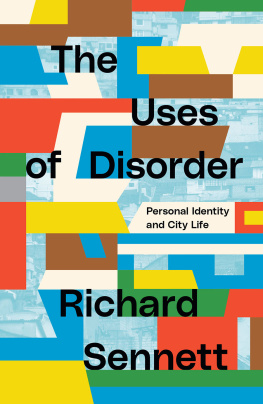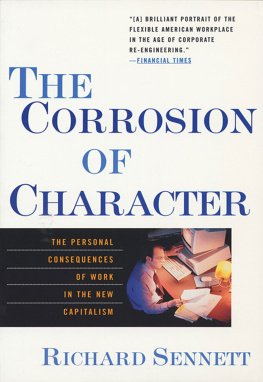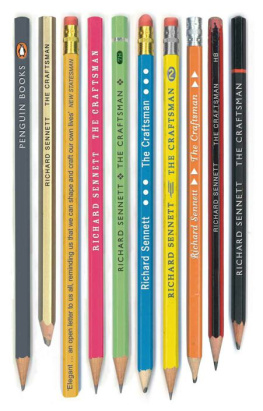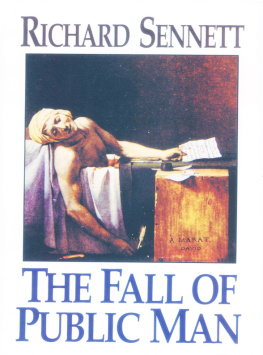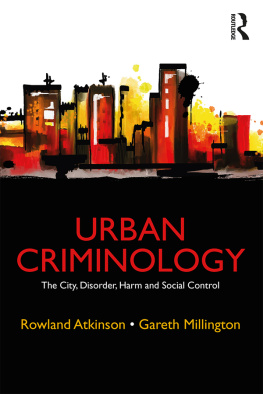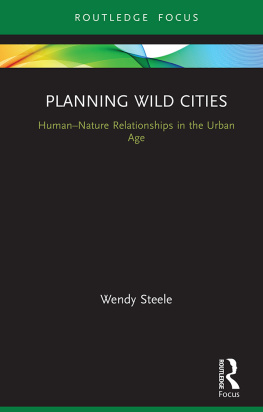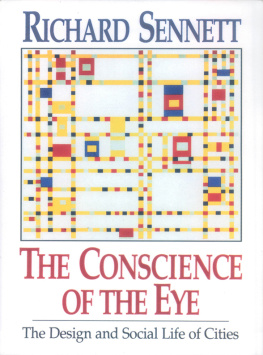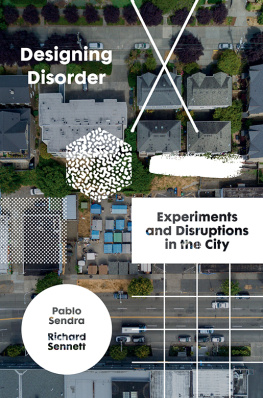Contents

THE USES OF DISORDER
RICHARD SENNETT
The
Uses of Disorder
PERSONAL IDENTITY AND CITY LIFE

This edition first published by Verso 2021
Paperback edition published by Yale University Press 2008
First published by Knopf 1970
Richard Langston 1970, 2008, 2021
All rights reserved
The moral rights of the author have been asserted
1 3 5 7 9 10 8 6 4 2
Verso
UK: 6 Meard Street, London W1F 0EG
US: 20 Jay Street, Suite 1010, Brooklyn, NY 11201
versobooks.com
Verso is the imprint of New Left Books
ISBN-13: 978-1-83976-408-0
ISBN-13: 978-1-83976-409-7 (UK EBK)
ISBN-13: 978-1-83976-410-3 (US EBK)
British Library Cataloguing in Publication Data
A catalogue record for this book is available from the British Library
Library of Congress Cataloging-in-Publication Data
A catalog record for this book is available from the Library of Congress
Printed and bound by CPI Group (UK) Ltd, Croydon CR0 4YY
For Carol
Acknowledgments
The idea for this book came to me during a walk with Erik Erikson one morning in a New England graveyard. I should like to thank him for the steady encouragement he gave me in subsequent months. I should also like to thank Jon Cobb, Jane White, and my wife, Carol, for helping me find the intellectual direction of my reflections. I owe a special debt of thanks to Angus Cameron, who helped me define the purpose of this book at a critical stage of the writing.
Contents
Most writers get only a few big ideas in their lives. I was lucky to have to have one when I was twenty-five: that by living in a big, messy city, you could develop as a human being. Challenged by living with others who differ from you, by the chance opportunities and discoveries spawned in a complex place, by the sheer density of urban experience, you could grow. But the cities of my youth, a half-century ago, did not accord with this possibility. They had diminished diversity and complexity. They were segregated by class and race so that different groups did not much interact; their parks and public spaces were un-peopled; big business and rigid master-plans were squeezing the life out of localities. Rigid organization and controls disabled the promise of experiential richness.
What was true then about physical space is true today about digital space. The Internet could also, in principle, enrich your experience, putting you in touch with a huge number of strangers, widening your horizons, but in fact it is standardizing and routinizing behavior, denying people the opportunity to become more complexity-capable persons. The top-down Internet, like the top-down city, needs to be challenged and opened up. At least, that is the connection I make between then and now, and why I hope that The Uses of Disorder still speaks.
There may seem one big difference between then and now. America and Western Europe were beginning to boom big in the 1960s, so that the question was how to shape this growth, how to use abundance. Today, economic resources are scarcer, at least for the mass of citizens: you have to be very rich or privileged to dwell on growth. The sixties, as a political label, names a time of great distress but also a huge amount of idealism among young people that things could be different than they are. Extreme inequality, which has reduced the horizon of opportunity, paralyzes the political imagination; people become cynical that anything much can be done.
As an elderly person, this is what I most fear about today. Realism spawns resignation, and resignation is no way to get through life. You can't be vigorously resigned. Perhaps time casts the sixties in too rosy a light, but its idealism gave us energy. Reading my essay now, I see a lot that is unrealistic and idealistic, but do not see this as a fault.
If I were to rewrite this book today, I would add more about how art can serve its aims. Some New York artists in the sixties sought to destabilize ordinary ways of seeing the city, as in Diane Arbus's photos and films by Jonas Mekas. Their work differed in spirit from the inward-turning abstractions of the decades before, paintings and poems that focused on art in and for itself. In architecture, something similar was beginning to stir in the sixties: instead of looking at buildings as splendid, stand-alone objects, people like Michael Sorkin and Max Bond paid serious attention to contextwhich meant, in New York, coming to grips with the city's messiness, which is to say, its dynamism. In this, they were responding to the call of Jane Jacobs, in her classic book, The Death and Life of Great American Cities, for complexity rather than clarity in built form.
My book, too, was inspired by hers, though even then I did not quite see eye to eye with Jacobs (who eventually became a great friend). She is the great champion of community; I was, even in The Uses of Disorder, interested in how people could set themselves free, in a big, dense, anonymous city, from the bonds of inward, self-contained, static community. A city is not a village. Freedom from fixed identity is what the political philosopher Hannah Arendt explored in books like The Human Condition, and in my later studies of public life, as in The Fall of Public Man, I tried to follow Arendt's lead.
Though I'm a thinker not a doer, The Uses of Disorder seemed in the course of time to strike a chord with community organizers as well as architects. One person who has applied its ideas to city-making is the planner Pablo Sendra. He has thought through the physical infrastructures that can support flexibility above ground, enabling divergent or even conflicting buildings and spaces to coexist. A companion volume to this republication of The Uses of Disorder is a new work, Designing Disorder, which Pablo and I have written together. My writerly hope is that The Uses of Disorder will provoke others more generally, outside the boundaries of professional practice, just because the city is both a place and a state of mind.
Richard Sennett, London, June 2021
During the past decade people of diverse social backgrounds and political opinions have awakened to the need to reconstruct city life. The riots forced mass attention on black poverty, but young people, who came alive in the 1960s after the silence of the previous generation, have developed an interest in cities that is more wide-ranging. For they have sensed in dense city life some possibility of fraternity, some new kind of warmth, that is now understood in the vague term community.
In large part, the search of young people outside the ghetto for urban community of this sort, for a relatedness and sharing, has been self-defeating. Some people tried to find this relatedness in the black ghetto itself, but the solidarity of the black brothers was bought at the expense of much pain and is not for outside consumption. The blacks told the affluent whites to find the warmth in themselves. Some people tried to find community by radicalizing the working class, but the working class is not buying a student alliance these days and broke kids heads when it responded to them at all.
So the search for community has come to be a search for some life principle in young people as they arewhite, affluent, and unhappy with the cocoons their parents spun around them. And the process of elimination that has forced this search back to an honest self-analysis has also brought the movement for social and personal renewal to a standstill. What does it mean for a white, educated, affluent person to feel a sense of community with other people? People in the suburbs have a sense of togetherness, of possessing an identity, a sense of 'we as a community, but that kind of social cohesion is exactly what most people nurtured in suburbs are seeking to escape. It is freedom of some kind that is included in this vague new ideal of community, but what kind of community freedom is there beyond the freedom from material want?

